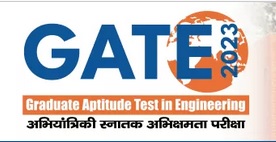GATE Life Sciences (XL) Syllabus 2023
Organisation : Graduate Aptitude Test In Engineering GATE
Exam Name : GATE Life Sciences (XL) Exam
Announcement : GATE Life Sciences (XL) Syllabus 2023
Website : https://gate.iitk.ac.in
GATE Life Sciences (XL) Syllabus
In each of the following subjects the topics have been divided into two categories – Core Topics and Special Topics. The corresponding sections of the question paper will contain 90% of their questions on Core Topics and the remaining 10% on Special Topics.
Related / Similar Syllabus : Joint Admission Test JAM Physics (PH) Syllabus 2022

Life Sciences (XL) Syllabus
Section 1: Atomic Structure and Periodicity
Planck’s quantum theory, wave particle duality, uncertainty principle, comparison between Bohr’s model and quantum mechanical model of hydrogen atom, electronic configuration of atoms and ions. Hund’s rule and Pauli’s exclusion principle. Periodic table and periodic properties: ionization energy, electron affinity, electronegativity and atomic size.
Section 2: Structure and Bonding
Ionic and covalent bonding, MO and VB approaches for diatomic molecules, VSEPR theory and shape of molecules, hybridization, resonance, dipole moment, structure parameters such as bond length, bond angle and bond energy, hydrogen bonding and van der Waals interactions. Ionic solids, ionic radii and lattice energy (Born‐Haber cycle). HSAB principle.
Section 3: s, p and d Block Elements
Oxides, halides and hydrides of alkali, alkaline earth metals, B, Al, Si, N, P, and S. General characteristics of 3d elements. Coordination complexes: valence bond and crystal field theory, color, geometry, magnetic properties and isomerism.
Section 4: Chemical Equilibria
Osmotic pressure, elevation of boiling point and depression of freezing point, ionic equilibria in solution, solubility product, common ion effect, hydrolysis of salts, pH, buffer and their applications. Equilibrium constants (Kc, Kp and Kx) for homogeneous reactions.
Section 5: Electrochemistry
Conductance, Kohlrausch law, cell potentials, EMF, Nernst equation, thermodynamic aspects and their applications.
Section 6: Reaction Kinetics
Rate constant, order of reaction, molecularity, activation energy, zero, first and second order kinetics, catalysis and elementary enzyme reactions. Reversible and irreversible inhibition of enzymes.
Section 7: Thermodynamics
Qualitative treatment of state and path functions, First law, reversible and irreversible processes, internal energy, enthalpy, Kirchoff equation, heat of reaction, Hess’s law, heat of formation. Second law, entropy and free energy. Gibbs Helmholtz equation, free energy change and spontaneity, Free energy changes from equilibrium constant.
Section 8:
** Structure-Reactivity Correlations and Organic Reaction Mechanisms Acids and bases, electronic and steric effects, Stereochemistry, optical and geometrical isomerism, tautomerism, conformers and concept of aromaticity.
** Elementary treatment of SN1, SN2, E1, E2 and radical reactions, Hoffmann/Saytzeff rules, addition reactions, Markownikoff rule and Kharasch effect. Elementary hydroboration reactions.
** Grignard’s reagents and their uses. Aromatic electrophilic substitutions, orientation effect as exemplified by various functional groups. Identification of common functional groups by chemical tests.

Download GATE Life Sciences (XL) Syllabus
Download Full GATE Life Sciences (XL) Syllabus Here :
http://www.syllabus.gen.in/uploads/pdf2022/3139.pdf